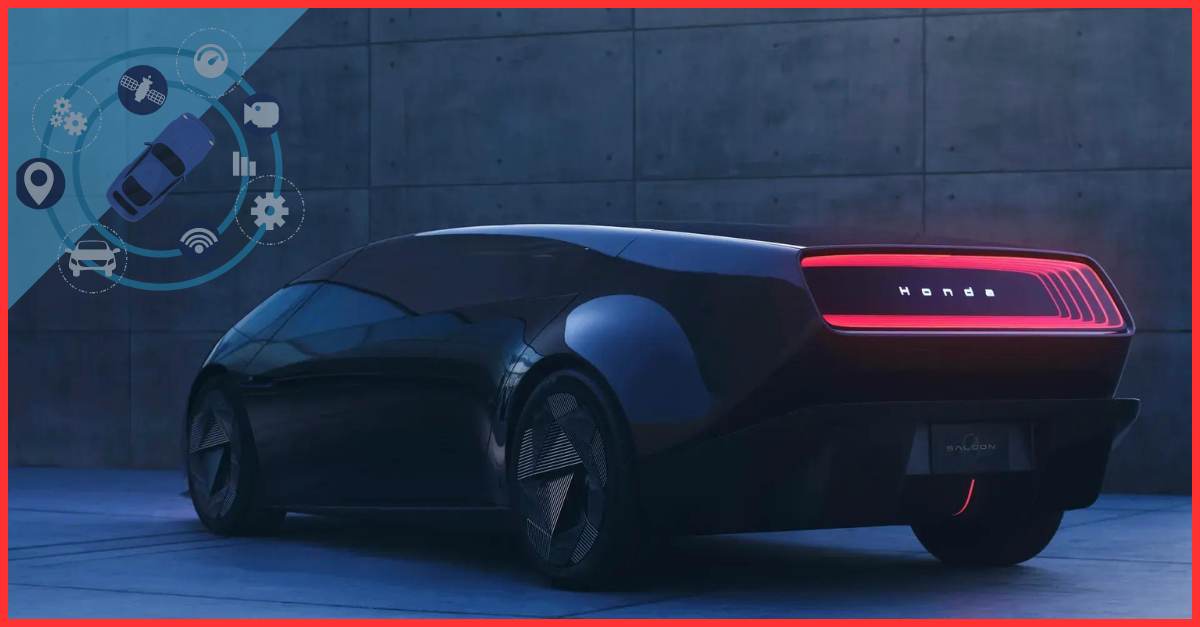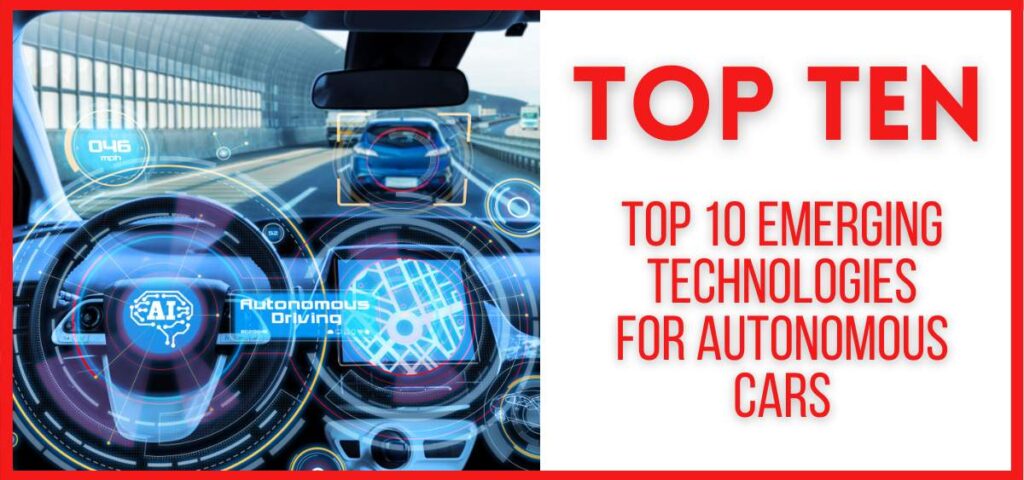We are calling on all tech enthusiasts and future road warriors! Autonomous cars (vehicles) are on the fast track, and we’re way beyond basic Autopilot features. Here, we’ll unveil the top 10 emerging technologies revolutionizing self-driving cars in 2025. We’ll explore how advanced sensors are creating a new level of perception, dive into the world of powerful AI and machine learning, and even explore the potential of quantum computing in autonomous vehicles. Prepare yourself to discover the importance of car-to-everything communication, the ever-evolving collaborative mapping, and the critical role of explainable AI in establishing trust. Buckle up and join us as we navigate the exciting future of autonomous vehicles!
Also, read Top 10 Reasons to Buy an Electric Car
Beyond Autopilot: Top 10 Emerging Technologies for Autonomous Cars in 2025
In 2025, the landscape of autonomous vehicles will be rapidly transforming. While the dream of self-driving cars has been around for decades, advancements in technology are pushing the boundaries of what’s possible. This surge of innovation is driven by a relentless pursuit of safer, more efficient, and more accessible transportation. From enhanced perception with advanced sensors to the power of next-generation AI, we’re on the cusp of a revolution in autonomous driving. Here, we delve into the top 10 emerging technologies that are shaping the future of autonomous cars in 2025 and beyond.

1. Advanced Sensor Technology
Autopilot may have given us a glimpse into the future, but for truly autonomous vehicles, the key lies in how they perceive the world around them. This is where advanced sensor technology comes in. Imagine high-resolution LiDAR creating detailed 3D maps of the environment, combined with powerful radar systems that track objects even in low-light conditions.
Advanced cameras with wider fields of view and superior image processing capabilities will capture everything from traffic signals to pedestrians’ gestures. These sensors are constantly evolving, becoming more accurate, compact, and affordable. This enhanced perception is the foundation upon which all other autonomous vehicle technologies rely, allowing self-driving cars to navigate complex road environments with unparalleled precision and safety.
Also, read: Top 10 Reasons to Buy Hybrid Cars
2. Enhanced High-Performance Computing (HPC)
Imagine your car navigating a chaotic rush hour, dodging pedestrians and cyclists while anticipating traffic light changes. The real-time decisions required for safe autonomous driving are mind-boggling. This is where enhanced high-performance computing (HPC) steps in as the brain behind the wheel. HPC packs a serious processing punch, allowing autonomous vehicles to analyze sensor data from cameras, LiDAR, and radar at lightning speed.
This data empowers the car to build a real-time picture of its surroundings, identify objects and potential hazards, and make critical split-second decisions. Advancements in HPC are making these calculations faster, more efficient, and more reliable, paving the way for autonomous vehicles to tackle complex situations with human-like reflexes.
Also, read: Ten things to consider when buying a hybrid car
3. Next-Gen Artificial Intelligence (AI) and Machine Learning (ML)
The brains behind the operation! Traditional AI just won’t cut it for the complex decision-making required in autonomous vehicles. That’s where next-gen AI and Machine Learning (ML) come in. These advanced algorithms go beyond simply reacting to traffic lights. They can process massive amounts of sensor data in real-time, allowing the car to perceive its surroundings with incredible detail.
Imagine the car not just seeing a pedestrian but understanding its intent, predicting its actions, and adjusting its course accordingly. Machine learning also allows the car to continuously learn and improve its performance over time. By analyzing past experiences and constantly refining its decision-making, next-gen AI is the key to unlocking a new level of autonomy, making self-driving cars not just possible but truly intelligent.
Also, read: Ten tips for improving your car’s fuel economy
4. Vehicle-to-Everything (V2X) Communication
Imagine a world where cars aren’t isolated bubbles on the road, but intelligent network members. That’s the promise of vehicle-to-everything (V2X) communication. Using a combination of WiFi, cellular networks, and dedicated short-range communication, V2X allows autonomous vehicles to talk to each other, traffic infrastructure, and even pedestrians. This real-time data exchange is a game-changer.
Cars can share information about location, speed, and even potential hazards like sudden braking or accidents. This allows for smoother traffic flow, as vehicles can adjust their speed and position cooperatively. But the biggest benefit is safety. V2X can warn autonomous vehicles of unseen dangers around corners or hidden by stopped traffic, preventing collisions and creating a safer driving experience for everyone.
Also, read: Ten tips for improving your car’s fuel economy
5. LiDAR with microlensing
LiDAR (Light Detection and Ranging) is a crucial sensor for autonomous vehicles, creating detailed 3D maps of their surroundings. However, traditional LiDAR systems can be bulky and expensive, hindering wider adoption in self-driving cars. Here’s where microlensing comes in as a game-changer. By incorporating microlens arrays, engineers can create LiDAR systems that are smaller, lighter, and significantly cheaper.
These microlenses manipulate the laser beam, achieving similar performance to traditional LiDAR in a more compact design. This breakthrough in LiDAR technology is paving the way for more affordable and accessible autonomous vehicles. With microlensing LiDAR, the dream of self-driving cars becomes more tangible, not just for high-end luxury vehicles but for mainstream car models, accelerating the autonomous driving revolution.
Also, read: Top Ten things to do when your car battery dies
6. Cyber Security Fortification
As autonomous vehicles become rolling tech titans, their reliance on software explodes. This opens a critical front: cyber security. Imagine a hacker taking control of your car! Yikes! To combat this, the industry is fortifying defenses with a multi-layered approach. Encryption scrambles sensitive data, making it unreadable for unauthorized access. Intrusion detection systems act as digital bouncers, constantly monitoring for suspicious activity.
Secure communication protocols ensure data travels on encrypted channels, protected from eavesdroppers. Regular software updates patch vulnerabilities before they can be exploited. This relentless focus on cyber security is paramount. By building a robust defense, we can ensure these self-driving marvels navigate the road, not the dark web.
Also, read: Top Ten Battery Technologies That Will Revolutionize the Automotive Industry
7. Advanced Driver-Monitoring Systems (DMS)
Even in the future of autonomous vehicles, driver monitoring remains a crucial safety feature. Advanced Driver-Monitoring Systems (DMS) take things a step further than ever before. Using high-resolution cameras and sophisticated algorithms, DMS can track a driver’s alertness, distraction, and even potential intoxication by monitoring eye closure frequency, head position, and facial expressions. This allows the DMS to detect signs of drowsiness, inattentiveness, or impairment much earlier than a human ever could. If the DMS identifies a risk, it can take action.
This might involve issuing audible or visual warnings to jolt the driver back to focus, or even disabling certain autonomous features and prompting the driver to take back control of the vehicle. DMS could even bring the car to a safe stop. By constantly monitoring the driver’s state, DMS acts as a watchful guardian in the autonomous car, ensuring a smooth and safe ride for everyone on the road.
Also, read: Top Ten Tips for Driving Safely in Winter Weather
8. Collaborative Mapping and Localization
Imagine a world where every autonomous vehicle on the road contributes to a constantly updated, hyper-accurate map. That’s the power of collaborative mapping and localization. This innovative technology allows self-driving cars to share real-time information about their surroundings, including road conditions, traffic patterns, and even the location of landmarks like potholes or construction zones. This collective data feeds into a central map that’s accessible to all connected vehicles. The key benefit is unprecedented levels of accuracy and adaptability.
Unlike static, pre-programmed maps, collaborative mapping allows autonomous vehicles to respond to dynamic changes on the road, making navigation safer and more efficient. Consider it a constantly evolving digital picture of the world, ensuring every self-driving car has the latest information for a smoother, more informed journey.
Also, read: Ten best luxury cars in the world
9. Explainable AI
Imagine this: you’re cruising down the highway in your autonomous car when a sudden maneuver surprises you. You wonder, Why did the car make that decision? This is where Explainable AI (XAI) comes in. Unlike traditional black-box AI, XAI allows us to understand the reasoning behind an autonomous vehicle’s choices. XAI techniques provide insights into how the car processes sensor data, identifies objects, and ultimately makes decisions.
This transparency is crucial for building trust with passengers and regulators. With XAI, developers can identify potential biases in the AI and address them before deployment. Additionally, XAI can be used to explain complex scenarios to law enforcement or insurance companies in the event of an accident. Ultimately, Explainable AI is paving the way for a future where we can trust our self-driving cars to make safe and responsible decisions, keeping us informed every step of the way.
Also, read: Top 10 Reasons to Buy Renault Megane
10. Quantum-Inspired Algorithms
While quantum computers are still under development, their underlying principles inspire a new wave of algorithms with the potential to revolutionize specific tasks within autonomous vehicles. These quantum-inspired algorithms leverage concepts like superposition (existing in multiple states simultaneously) and entanglement (linked qubits that influence each other instantaneously) to tackle complex problems uniquely.
In the context of autonomous vehicles, this could translate to breakthroughs in areas like route optimization. Imagine a scenario where a car needs to navigate rush-hour traffic. A quantum-inspired algorithm could explore all possible routes simultaneously, factoring in real-time traffic data and potential delays, to identify the absolute fastest or most fuel-efficient route—something classical algorithms struggle with as the number of variables increases. While these algorithms are still in their early stages of development and implementation within autonomous vehicles, they represent a glimpse into the future where quantum-inspired technology can push the boundaries of what’s possible on the road.
Also, read: Top 10 Warning Signs Your Electric Vehicle Needs Service
FAQs
Q. What is the latest technology for cars in 2025?
Top Automotive Trends To Watch Out For In 2025
- Autonomous Driving Technology.
- Connectivity and entertainment systems.
- Sustainable Manufacturing Practices.
- Shared Mobility and Subscription Services.
- Advanced Safety Features.
- Lightweight and high-strength materials.
- Customization and personalization.
- Integration with smart cities.
Q. What are the new technologies in autonomous cars?
Various types of sensors provide autonomous cars with the ability to “see” their surroundings, which is a critical enabling factor for success. Types of sensors for acquiring external data include LiDAR (light detection and ranging), RADAR, ultrasonic, and cameras.
Also, read: Top 10 Electric Vehicle Technologies
Q. Will LiDAR with microlensing make self-driving cars cheaper?
Yes, LiDAR with microlensing is a promising technology that could significantly reduce the cost of LiDAR sensors, which are currently a major expense in autonomous vehicles. This could make self-driving cars more affordable for consumers in the future.
Q. How will V2X communication improve safety on the road?
V2X communication allows autonomous vehicles to “talk” to each other, as well as to traffic infrastructure and pedestrians. This real-time data sharing can provide crucial information about accidents, road closures, and even the movements of other vehicles. By being aware of their surroundings in more detail, autonomous vehicles can make safer decisions and avoid collisions.
Q. What is explainable AI, and why is it important for autonomous vehicles?
Explainable AI helps us understand how the AI system in an autonomous vehicle makes decisions. This transparency is important for several reasons. It allows developers to identify and fix any biases in the AI, builds trust with the public who will be using these vehicles, and helps regulatory bodies assess the safety and effectiveness of autonomous driving technology.
Also, read: Top 10 Advancements in Electric Vehicle Charging Infrastructure in 2025
Q. Are advanced driver-monitoring systems necessary in self-driving cars?
Even in autonomous cars, driver monitoring can be important. In situations where the car needs to hand back control to the driver, a DMS can ensure the driver is alert, focused, and capable of taking over safely. Additionally, DMS can be used to prevent misuse of autonomous features or detect potential medical emergencies behind the wheel.
Q. How will quantum-inspired algorithms impact autonomous vehicles?
Quantum computing is a complex field, but researchers are exploring how algorithms inspired by quantum mechanics can improve specific tasks in autonomous vehicles. This could involve optimizing routes for maximum efficiency or processing sensor data from the vehicle’s environment in a more sophisticated way. While quantum computers themselves may not be directly used in autonomous vehicles shortly, these inspired algorithms hold promise for future advancements.
Conclusion: The Final Thought
As we stand on the precipice of a new era in transportation, the rapid evolution of technology is propelling us towards a future dominated by autonomous cars in 2025. The convergence of artificial intelligence, machine learning, and advanced sensors has laid the foundation for self-driving vehicles that promise to revolutionize our daily lives. From safer roads to reduced traffic congestion, the potential benefits of autonomous cars in 2025 are far-reaching. However, challenges such as regulatory hurdles, ethical considerations, and cybersecurity threats must be addressed to ensure a seamless transition. As we continue to innovate and refine these emerging technologies, it is imperative to strike a balance between technological advancement and societal well-being. By embracing the transformative power of autonomous cars in 2025, we can unlock a future of greater efficiency, sustainability, and accessibility for all.
Also, read: Top 10 Myths About Electric Vehicle Maintenance Busted


































